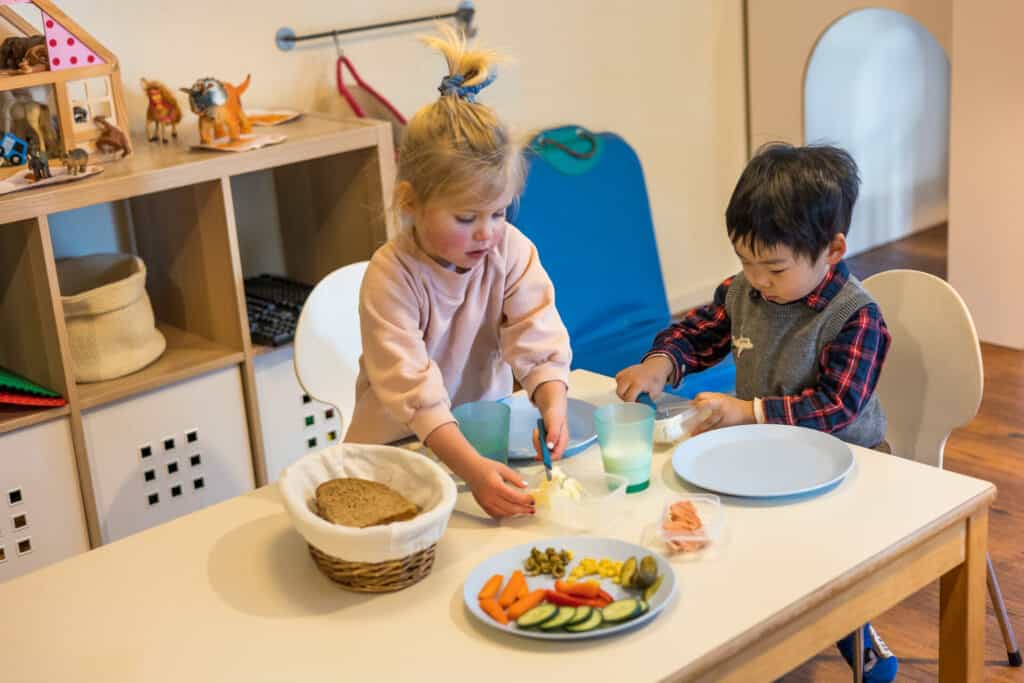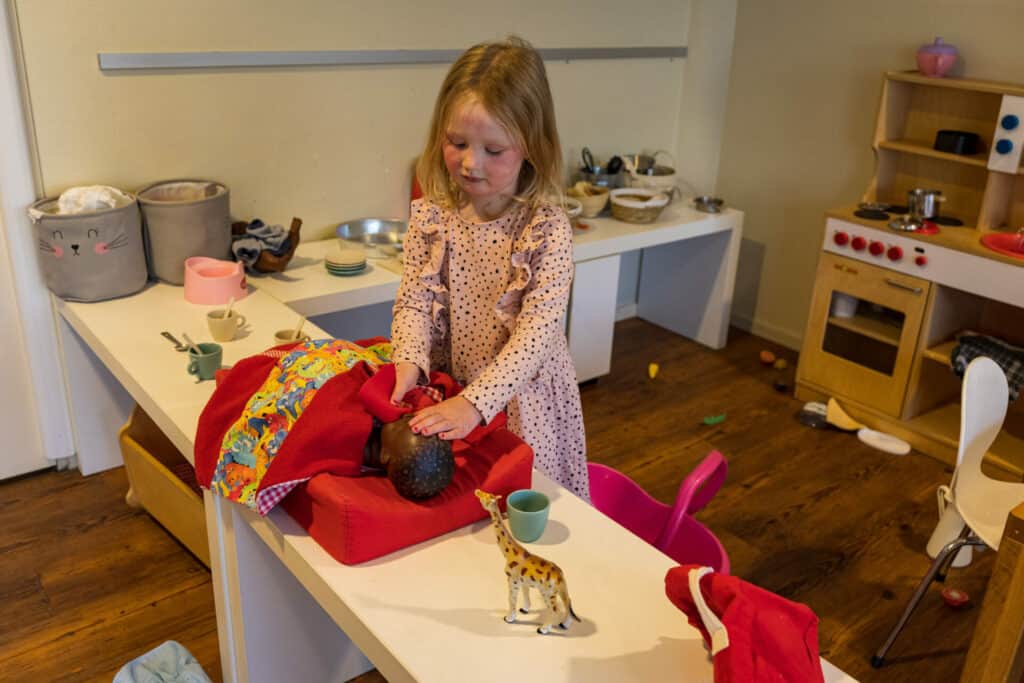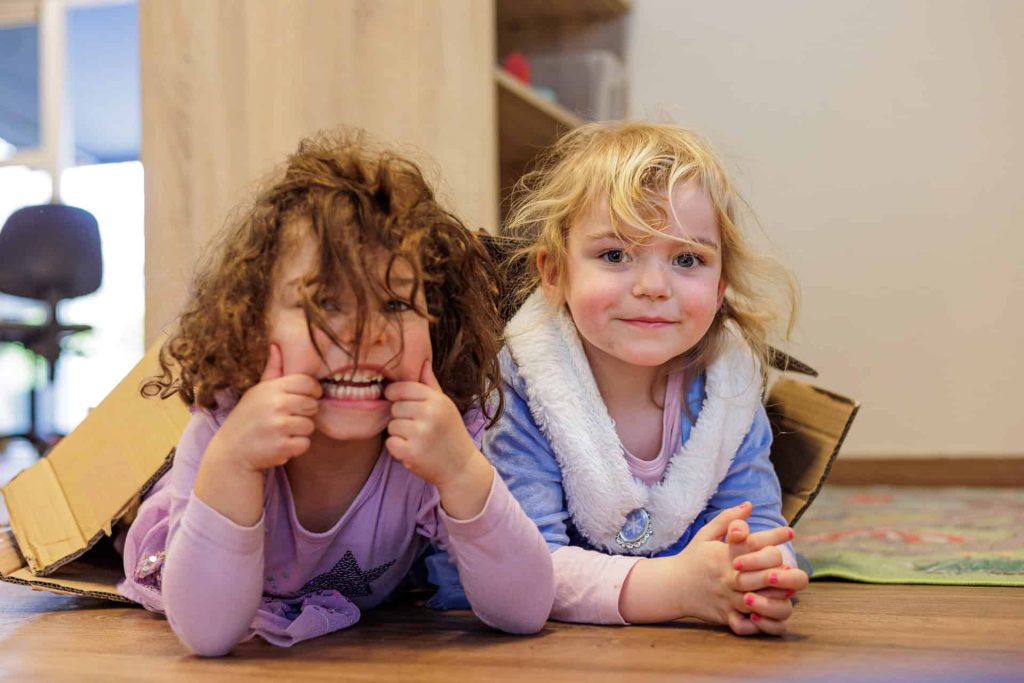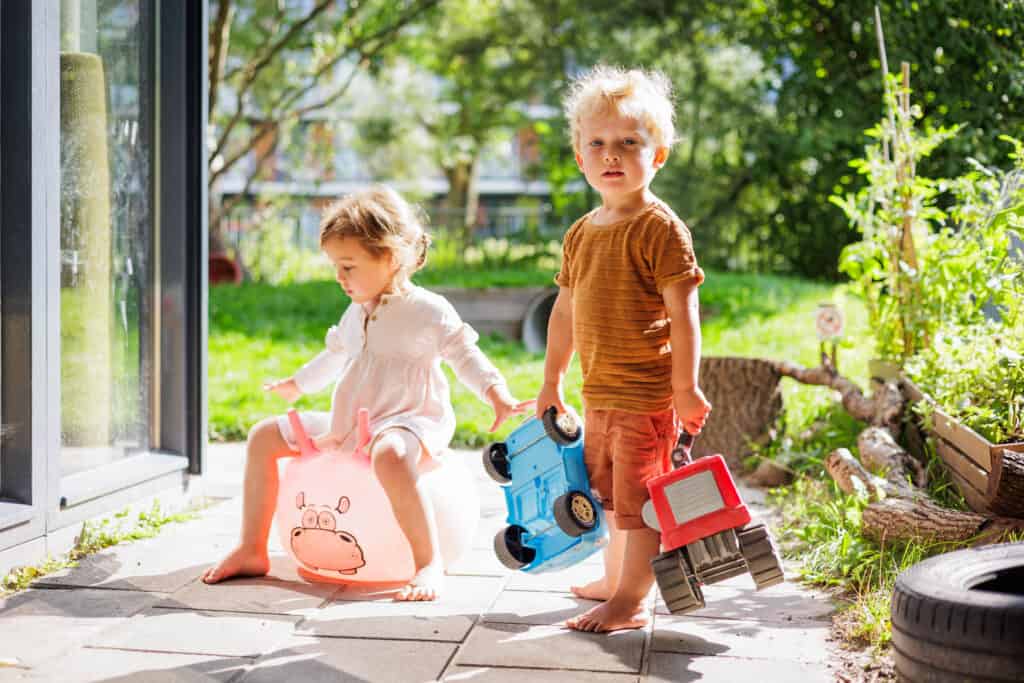Your child is 2.5 – 4 years old
The timeline below shows the key milestones in your child’s development during this age. We should like to tell you about the things children experience in each developmental area and, of course, we also want to explain how we respond to this at KinderRijk.
Learn more about…

1. Motor skills
Climbing the stairs or running without falling down… your toddler’s motor development is improving. Movements are becoming more refined, which is something that is clearly visible in drawing, for example. Your child’s muscles are becoming stronger all the time. Children who have learnt to understand their own bodies very well will enjoy moving around a great deal. They need to release their energy and space to run. Your child will also learn to concentrate on the same thing for longer periods of time.
Having a good time outside
Toddlers have a tremendous need to move. We make sure they can release their energy by taking the children outside. In the nature garden, your child can run, jump, climb, balance and practise their motor skills to the full. Different types of surfaces such as grass, tiles, wood chips and sand provide a different feel and motor skills.
As we offer different activities such as dancing and yoga, children learn to understand their bodies and gross motor skills are encouraged. Children also enjoy rolling, jumping or other forms of exercise.
Your child will learn about different materials by drawing, claying or painting at our workshops. By mixing paints, your child learns to discover new colours and his fine motor skills are being developed.

Milestones
-
Catching balls
When children of this age catch a ball they clench it against their chest.
-
Drawing
Between the age of three and four, your child develops a preference for the left or right hand. They can draw a vertical line or a circle. They can also cut a little and start drawing people. These are the famous stick figures.
-
Eating with a spoon and fork
Your child develops the skill of eating with a spoon and taking a piece of food with a fork.
-
Self-confidence
Your child is full of self-confidence. You can see this, for example, by their climbing, scrambling and running without falling.
-
Putting on and taking clothes off
At this age, your child practices putting on and taking off clothes. Self-sufficiency increases. Your child develops the skill of opening and closing large buttons.
“TODDLERS HAVE A TREMENDOUS NEED TO MOVE. WE MAKE SURE THEY CAN RELEASE THEIR ENERGY BY TAKING THE CHILDREN OUTSIDE.”


2. Language development
Your child’s language becomes richer and more complex at this age. He begins to understand the rules of language and will be having increasingly more types of words at his disposal. As he learns more new words, he expands his way of thinking: as soon as he can name an object, situation or feeling, he can also think about it. Moreover, he is increasingly able to talk to others about the things he has experienced or what he is feeling. Language and thinking interact with each other.
Creative expressions
Children communicate through creative expressions, play, music, movement, dance and body language. By observing them in all this and listening to them, we expand our communication with the children. It’s really fascinating to hear what children have to say about their own works of art. Whenever possible, we write this down with their artworks.
We have lots of conversations with the children, which helps to increase their vocabulary. We talk in a calm and clear way so that your child can understand and learn the words well. Sometimes we “correct” children’s wording by repeating their sentence in the right order and with the right words.
Between the ages of 2.5 and 4, language development runs in parallel with social-emotional, motor, cognitive-sensory and personal development. This so-called parallel development, in which all areas develop at the same rate, is specific to this age stage. We focus on the child’s broad development and offer activities that stimulate all areas of development, such as language games, rhymes, singing, playing with finger puppets or puppet shows.
“CHILDREN COMMUNICATE THROUGH CREATIVE EXPRESSIONS, PLAY, MUSIC, MOVEMENT, DANCE AND BODY LANGUAGE.”
Milestones
-
Making up words
Your child is able to think about things for which he doesn’t yet know the word. He will make up his own word to be able to talk about these things anyway.
-
Grammar
Your child will gain increasing insight into the rules of grammar: for example, he or she will start practising singular and plural and learn to conjugate verbs.
-
Questions
Asking questions is no longer done only with intonation; your child will also start changing the word order to turn a sentence into a question.
-
Speech motor skills
Your child starts speaking increasingly more clearly. Still, some words or sounds remain difficult to pronounce. For example, “animal” often becomes “aminal”.
-
Differentiation phase
Expansion of vocabulary from several hundreds to several thousands of words. Children learn to make negating sentences by using auxiliary verbs.

3. Cognitive development
Cognitive development increases rapidly at this age. Your child is no longer the centre of attention while playing: he or she will actually start playing with or side by side with others. Your child is increasingly able to imagine that, for example, a photo or drawing can represent something from the ‘real’ world. This is also the age of ‘magical thinking’: your toddler believes in magic and can attribute events he cannot explain to this magic: “The doll is not allowed in the toy basket, because she won’t be able to see anything”. “I’m a superwoman, I can fly”.

Help
Imitation and fantasy go together: making food in the kitchenette, changing nappies for the dolls, drinking tea at the table. Dressing up, an iron and household materials are popular to older toddlers. The educational staff member observes the play and adds something if the children get stuck in their play.
Children like to help with everything and so they can: setting the table, washing up, folding laundry, sweeping up leaves in the garden, cleaning windows. Staff also invite children to help and ask which task they want to take on. This makes children feel seen and taken seriously.
We involve children where we can in making agreements and drawing up (group) rules. This gives them more control and makes the rule feel ‘their own’ and they are more likely to follow it. This also increases their cause-and-effect understanding. For example, children discover that there is hardly any sand left in the sand table after playing with other children. The corresponding agreement (and fun activity) is to use a dustpan and brush to put the sand that has fallen next to it back into the table after playing with the sand table. This way, your child learns to appreciate materials through play.
Milestones
-
Becoming toilet-trained
Around 2.5 years old, the process of toilet training starts.
-
Burgeoning arithmetic
Your child will learn concepts such as content, comparison, weighing, measuring, back and in front.
-
Magic
There is no clear distinction between fantasy and reality yet. Magic disappears around the age of 6. Cause and effect tell your child nothing yet. Children make up their own story for everything that doesn’t seem right. If a child bumps into a table, the table is “naughty”.
-
Cleaning up
Young toddlers need specific directions to clean up. Older toddlers can already do this more independently but not yet on their own.
-
Drawing
From about the age of 3, your child will start drawing the first picture of a person. These are the stick figures.
-
Planning
Toddlers have difficulty putting off their needs (inhibition). They know what they want, they want it now and certainly not later.
“CHILDREN LIKE TO HELP WITH EVERYTHING AND SO THEY CAN: SETTING THE TABLE, WASHING DISHES, FOLDING LAUNDRY, SWEEPING LEAVES IN THE GARDEN, CLEANING WINDOWS.”


4. Personality development
For your child to talk to the people around him is not only essential to your child’s language development, but also to the development of his self-awareness. For self-knowledge, your child needs to be able to look at himself from a distance, so to speak. Self-knowledge is your child’s subjective judgment of himself. It is influenced by his self-esteem. Your child therefore needs to sufficiently experience that he matters and that he is of value to those who look after him.
Doing things by yourself
We give toddlers plenty opportunity to do as much as possible by themselves, meeting their need to gradually take more initiative. Children often manage to undress themselves at this age, and getting dressed by themselves also improves. This gives your child a great deal of satisfaction. As children in this age phase no longer depend on an adult for everything, their confidence grows tremendously.
Fantasy and reality are still hard to tell apart. Everything is possible, just like in fairy tales. Fantasy can therefore be fun, but also scary. We take fears seriously. Together, we chase away the crocodile or the dragon and say that they do not belong in the group or in the house. We take fears seriously but don’t blow up the fantasy by paying too much attention to them.
“WE GIVE TODDLERS PLENTY OPPORTUNITY TO DO AS MUCH AS POSSIBLE BY tHEMSELVES, MEETING THEIR NEED TO GRADUALLY TAKE MORE INITIATIVE.”
Milestones
-
Conscience
Your child develops a conscience and becomes more aware of what is right or wrong.
-
Initiative
As a result of growing self-confidence, your child will gradually start taking more initiative on his or her own.
-
Self-knowledge
From the age of 3, your toddler develops incipient self-knowledge.
-
Schame
Your child may dislike being the centre of attention at a party or in case the child is reprimanded. Also, he may feel embarrassed if something fails when trying something out.
-
Preference
Your child may develop a preference for one of the parents and sometimes play them off against each other. For example, your child may suddenly want to be put to bed only by daddy.


5. Social-emotional development
Your child starts to develop a will of his own up to the age of 3. This is the age when toddler puberty takes place: the phase when your child opposes you and uses “no” as his favourite word. This can be a difficult period for you as a parent, yet in this period, your child learns to deal with emotions such as anger and disappointment. From the age of three, your child becomes increasingly more social. This is reflected in interaction with other children, putting emotions into words and empathising with others.

Emotions are allowed
Your child is given space to experience and express emotions here at KinderRijk. Stomping feet due to fatigue or anger is fine, but hitting another child is not. By naming the emotion, the child experiences a sense of recognition. We explain why something cannot be done and listen to the child’s opinion and what preceded it in a particular situation. Emotions are therefore allowed and we do not suppress them by promises or something extra. Crying and anger are allowed, but if the child gets stuck in it, we will distract him.
Your child will be taught short words such as “no” or “stop”, “I don’t like that” etc. in order to teach him to set his limits and make him resilient. We teach the children to speak in the I form and we do the same. If something is not possible, we explain why it is not possible and name the alternative in a positive way. For example, we will not tell children that they are not allowed to run in the corridor. Instead, we prefer to say that they can walk quietly.
Toddlers want to feel they belong and look up to friends. Assisted by the educational staff, children learn empathy, understanding of others and social awareness. Children help each other put on their coats and comfort each other when hurt. Your child learns social behaviour through play. Toddlers can accept simple rules of play. The educational staff now introduce and practise the concept of taking turns and also winning and losing by playing games.
During this period, small clashes take place that are often resolved by themselves. If the children do not manage to solve them together, the educational staff member will help them. By having the children listen to each other and naming the emotions for them, they gain more insight into the feelings of others and learn to bear these feelings in mind. Toddlers learn and process things by imitating them. Dress-up clothes, cuddly toys, dolls, tea sets, all these materials help them with this. Your child learns to cooperate through play.
Milestones
-
Collaboration
Your child starts playing together with others more often. Playing with two children works better than playing with more children.
-
Friendship
During this period, the first friendships are made.
-
Tantrums
As your child is not yet able to plan very well, he does not yet oversee some of the steps. When you pick up your child and think it’s time to go home, this may come as a surprise to the child and may lead to a tantrum.
-
Making agreements
The rules agreed upon together are more likely to be accepted by your child.
“YOUR CHILD IS GIVEN SPACE TO EXPERIENCE AND EXPRESS EMOTIONS AT KINDERRIJK”.

Are you curious about other developmental stages?

